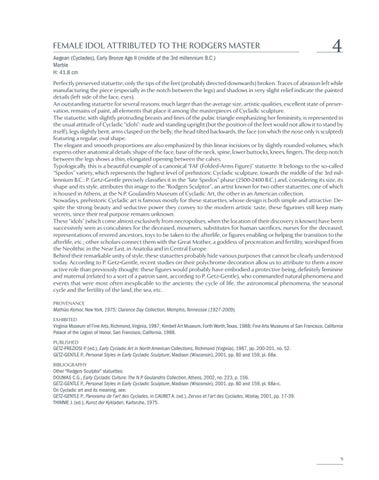FEMALE IDOL ATTRIBUTED TO THE RODGERS MASTER
4
Aegean (Cyclades), Early Bronze Age II (middle of the 3rd millennium B.C.) Marble H: 41.8 cm Perfectly preserved statuette; only the tips of the feet (probably directed downwards) broken. Traces of abrasion left while manufacturing the piece (especially in the notch between the legs) and shadows in very slight relief indicate the painted details (left side of the face, eyes). An outstanding statuette for several reasons: much larger than the average size, artistic qualities, excellent state of preservation, remains of paint, all elements that place it among the masterpieces of Cycladic sculpture. The statuette, with slightly protruding breasts and lines of the pubic triangle emphasizing her femininity, is represented in the usual attitude of Cycladic “idols”: nude and standing upright (but the position of the feet would not allow it to stand by itself), legs slightly bent, arms clasped on the belly; the head tilted backwards, the face (on which the nose only is sculpted) featuring a regular, oval shape. The elegant and smooth proportions are also emphasized by thin linear incisions or by slightly rounded volumes, which express other anatomical details: shape of the face, base of the neck, spine, lower buttocks, knees, fingers. The deep notch between the legs shows a thin, elongated opening between the calves. Typologically, this is a beautiful example of a canonical “FAF (Folded-Arms Figure)” statuette. It belongs to the so-called “Spedos” variety, which represents the highest level of prehistoric Cycladic sculpture, towards the middle of the 3rd millennium B.C.: P. Getz-Gentle precisely classifies it in the “late Spedos” phase (2500-2400 B.C.) and, considering its size, its shape and its style, attributes this image to the “Rodgers Sculptor”, an artist known for two other statuettes, one of which is housed in Athens, at the N.P. Goulandris Museum of Cycladic Art, the other in an American collection. Nowadays, prehistoric Cycladic art is famous mostly for these statuettes, whose design is both simple and attractive. Despite the strong beauty and seductive power they convey to the modern artistic taste, these figurines still keep many secrets, since their real purpose remains unknown. These “idols” (which come almost exclusively from necropolises, when the location of their discovery is known) have been successively seen as concubines for the deceased, mourners, substitutes for human sacrifices, nurses for the deceased, representations of revered ancestors, toys to be taken to the afterlife, or figures enabling or helping the transition to the afterlife, etc.; other scholars connect them with the Great Mother, a goddess of procreation and fertility, worshiped from the Neolithic in the Near East, in Anatolia and in Central Europe. Behind their remarkable unity of style, these statuettes probably hide various purposes that cannot be clearly understood today. According to P. Getz-Gentle, recent studies on their polychrome decoration allow us to attribute to them a more active role than previously thought: these figures would probably have embodied a protective being, definitely feminine and maternal (related to a sort of a patron saint, according to P. Getz-Gentle), who commanded natural phenomena and events that were most often inexplicable to the ancients: the cycle of life, the astronomical phenomena, the seasonal cycle and the fertility of the land, the sea, etc. PROVENANCE
Mathias Komor, New York, 1975; Clarence Day Collection, Memphis, Tennessee (1927-2009). EXHIBITED
Virginia Museum of Fine Arts, Richmond, Virginia, 1987; Kimbell Art Museum, Forth Worth, Texas, 1988; Fine Arts Museums of San Francisco, California Palace of the Legion of Honor, San Francisco, California, 1988. PUBLISHED
GETZ-PREZIOSI P. (ed.), Early Cycladic Art in North American Collections, Richmond (Virginia), 1987, pp. 200-201, no. 52. GETZ-GENTLE P., Personal Styles in Early Cycladic Sculpture, Madison (Wisconsin), 2001, pp. 80 and 159, pl. 68a. BIBLIOGRAPHY
Other “Rodgers Sculptor” statuettes: DOUMAS C.G., Early Cycladic Culture: The N.P. Goulandris Collection, Athens, 2002, no. 223, p. 156. GETZ-GENTLE P., Personal Styles in Early Cycladic Sculpture, Madison (Wisconsin), 2001, pp. 80 and 159, pl. 68a-c. On Cycladic art and its meaning, see: GETZ-GENTLE P., Panorama de l’art des Cyclades, in CAUBET A. (ed.), Zervos et l’art des Cyclades, Vézelay, 2001, pp. 17-39. THIMME J. (ed.), Kunst der Kykladen, Karlsruhe, 1975.
9
